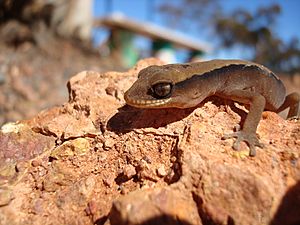Clawless geckos facts for kids
Quick facts for kids Clawless geckos |
|
|---|---|
 |
|
| Crenadactylus ocellatus | |
| Scientific classification |
|
| Kingdom: | Animalia |
| Phylum: | Chordata |
| Class: | Reptilia |
| Order: | Squamata |
| Family: | Diplodactylidae |
| Genus: | Crenadactylus Dixon & Kluge, 1964 |
Crenadactylus, also known as the clawless geckos, are named for their most special feature: they don't have claws on their toes! They are the only geckos in Australia from the Gekkonidae family that don't have claws. This group of geckos is also the smallest in size.
About Clawless Geckos
These geckos are super small, some of the tiniest in Australia! You can find them in central and western parts of the country. Their most special feature is that they don't have claws on their toes. Scientists have studied their bones and found that their toes are quite unique, especially because they lack claws.
Even though they are tiny and look similar, different types of clawless geckos have grown apart over time. They live in many different habitats across a wide area of Australia.
Different Types of Clawless Geckos
Scientists group animals into families. The Crenadactylus geckos are part of the Diplodactylidae family, which includes other geckos and some limbless lizards. For a long time, scientists thought there was only one type of clawless gecko. But thanks to new research, we now know there are several different species!
Here are the types of clawless geckos that scientists have identified:
- Crenadactylus horni – Central Uplands clawless gecko
- Crenadactylus naso – Northern clawless gecko
- Crenadactylus occidentalis – Western clawless gecko
- Crenadactylus ocellatus
- Crenadactylus pilbarensis – Pilbara clawless gecko
- Crenadactylus rostralis – Southwest Kimberley clawless gecko
- Crenadactylus tuberculatus – Cape Range clawless gecko
The name Crenadactylus was first used in 1964 by two scientists, James R. Dixon and Arnold G. Kluge. They wanted to give a special name to the gecko that John Edward Gray had described back in 1845. Dixon and Kluge noticed the unique shape of the bones in the gecko's toes, especially that they didn't have claws.
For many years, people thought Crenadactylus ocellatus was the only species, or maybe had a few subspecies (like different versions of the same species). But in 2016, scientists used DNA to study these geckos. They found many "hidden species" that looked alike but were actually different! This research showed that there were at least seven distinct species.
Scientists were surprised to find so many new species in a country like Australia. This discovery helps us understand how important it is to protect different types of animals, even if they look similar. The DNA evidence also showed that these different gecko groups have been separate for millions of years.
Where They Live
Before scientists found all the new species, people thought clawless geckos lived across most of western and central Australia. Now we know that each species often lives in a smaller, more specific area.
You can find these tiny geckos in many different places. They might live in the leaf litter on the ground in woodlands, under rocks, or in clumps of spiky spinifex grass. They also hide under logs and other dead wood. Sometimes, they even live under piles of rubbish left by humans!
Because they are so small, these geckos can't travel very far. This means they often stay in their local environment. Their small size might have also helped them survive big climate changes over millions of years.

